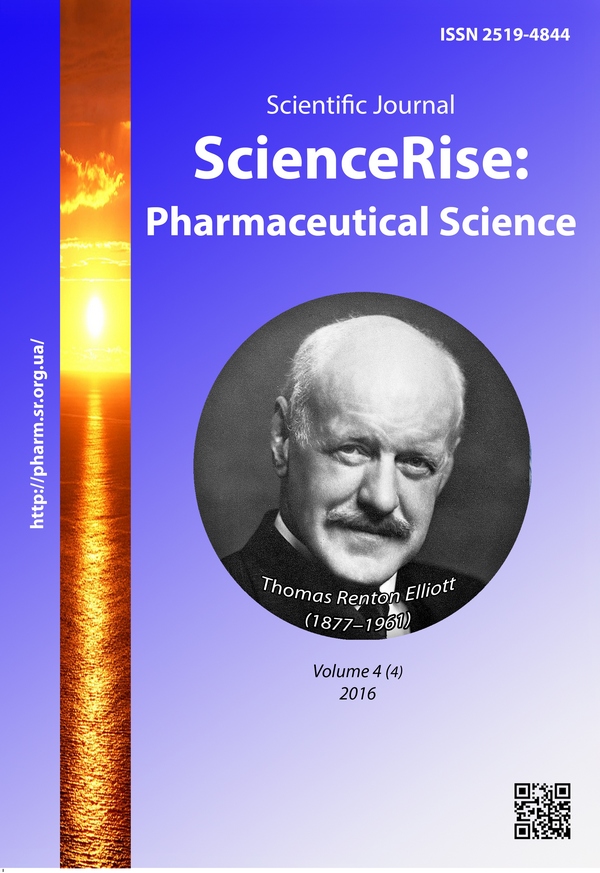Technology scaling for obtaining N,N –dibenzyl amide of malonic acid – a potential anticonvulsant – in industrial environments
DOI:
https://doi.org/10.15587/2519-4852.2016.87441Keywords:
synthesis, N, N-dybenzyl amid of malonic acid, anticonvulsant activity, reaction latency, reagents ratioAbstract
In result of a targeted synthesis, a promising substance for new anticonvulsant drug creation – symmetrical dybenzyl amid of malonic acid – was found.
The ability to be synthesized in one stage from available reagents and with high yield, as well as to show in animal experiments anticonvulsant activity with low toxicity is specific for the given substance.
The aim of our research was to determine optimal conditions for synthesis of N,N- dybenzyl amid of malonic acid and to scale the method in industrial production.
Methods. N,N- dybenzyl amid of malonic acid was obtained by synthesis. Purity was estimated using chromatographic methods. Crystals microscopy was carried out for study physical and chemical properties of the synthesized dybenzyl amid of malonic acid.
Results. In result of research, the method of N,N- dybenzyl amid of malonic acid synthesis was elaborated under manufacturing conditions; the influence of the reaction latency and reagents ratio on the product yield was studied.
Conclusion. The method of N,N- dybenzyl amid of malonic acid synthesis was elaborated under manufacturing conditions considering modern requirements to the active pharmaceutical ingredients quality and safety. The choice of the initial substances, solvent, synthesis and purification conditions was substantiated to ensure the final product’s appropriate purity and high yield.
The obtained results can be used for N,N- dybenzyl amid of malonic acid synthesis in industrial environmentsReferences
- Georgiyants, V. A., Kushniruk, V. M., Bezugly, P. O. (2016). “Greening” of amizone synthesis when manufacturing. News of pharmacy, 1 (85), 50–53.
- Kourti, T. (2009). Quality by Design in the Pharmaceutical Industry: Process Modelling, Monitoring and Control using Latent Variable Methods. IFAC Proceedings Volumes, 42 (11), 36–41. doi: 10.3182/20090712-4-tr-2008.00007
- Pallagi, E., Ambrus, R., Szabo-Revesz, P., Csoka, I. (2015). Adaptation of the quality by design concept in early pharmaceutical development of an intranasal nanosized formulation. International Journal of Pharmaceutics, 491 (1-2), 384–392. doi: 10.1016/j.ijpharm.2015.06.018
- Tiwari, P., Chowdhury, S. R. (2014). Sustainable Production of Highly Active Pharmaceutical Ingredients (HAPIs). International Journal of Scientific and Research Publications, 4 (3), 1–5.
- Anastas, P. T., Warner, J. C. (1998). Green Chemistry: Theory and Practice. New York: Oxford University Press, 30.
- Dunn, P. J., Wells, A. S., Williams, M. T. (Eds.) (2010). Green chemistry in the pharmaceutical industry. Williams John Wiley & Sons, 368.
- Fengli, Yu., Yuliang, Z., Zilin, J. (2003). Progress on synthesis of ibuprofen with green methodology. Chinese Journal of Organic Chemistry, 23 (11), 1198–1204.
- Dale, D. J., Dunn, P. J., Golightly, C., Hughes, M. L., Levett, P. C., Pearce, A. K. et. al. (2000). The Chemical Development of the Commercial Route to Sildenafil: A Case History. Organic Process Research & Development, 4 (1), 17–22. doi: 10.1021/op9900683
- Dunn, P. J., Galvin, S., Hettenbach, K. (2004). The development of an environmentally benign synthesis of sildenafil citrate (Viagra™) and its assessment by Green Chemistry metrics. Green Chemistry, 6 (1), 43–48. doi: 10.1039/b312329d
- Savile, C. K., Janey, J. M., Mundorff, E. C., Moore, J. C., Tam, S., Jarvis, W. R. et. al. (2010). Biocatalytic Asymmetric Synthesis of Chiral Amines from Ketones Applied to Sitagliptin Manufacture. Science, 329 (5989), 305–309. doi: 10.1126/science.1188934
- Fortunak, J., Byrn, S., Dyson, B., Ekeocha, Z., Ellison, T., King, C. et. al. (2013). An Efficient, Green Chemical Synthesis of the Malaria Drug, Piperaquine. Tropical Journal of Pharmaceutical Research, 12 (5), 791–798. doi: 10.4314/tjpr.v12i5.20
- Nelson, W. M. (2003). Green solvents for chemistry. New York: Oxford University Press, 400.
- Chodankar, N. (2016). Use of Catalysis for API Manufacturing. Industrial Catalytic Processes for Fine and Specialty Chemicals, 509–595. doi: 10.1016/b978-0-12-801457-8.00012-4
- Georgіjanc, V. A., Maloshtan, L. M., Kostochka, V. O., Bezuglij, P. O., Ukrainec, І. V. (2004). Pat. # UA 706685A. Dibenzilamіd malonovoi kisloti, jakij projavljae protisudomnu aktivnіst. MPK A61K 31/165, A61K 31/19, A61P 25/08, C07C 55/08. # 20031212132; declareted: 23.12.2003; published 15.10.2004, Bul. # 10.
- Smit, A., Dilman, A. D. (2015). Osnovy sovremennogo organicheskogo sinteza. Moscow: BINOM. Laboratorija znanij, 750.
- Brown, W. H., Iverson, B. L., Anslyn, E., Foote, C. S. (2013). Organic Chemistry. Brooks Cole, 1312.
- Korolev, D. V., Suvorov, K. A. (2002). Opredelenie dispersnogo sostava poroshkov mikroskopicheskim metodom. Saint Petersburg: SPbGTI (TU), 24.
Downloads
Published
How to Cite
Issue
Section
License
Copyright (c) 2016 Інна В’ячеславівна Ковалевська, Василь Миколайович Кушнірук, Олена Анатоліївна Рубан, Наталія Василівна Гарна, Вікторія Акопівна Георгіянц

This work is licensed under a Creative Commons Attribution 4.0 International License.
Our journal abides by the Creative Commons CC BY copyright rights and permissions for open access journals.








